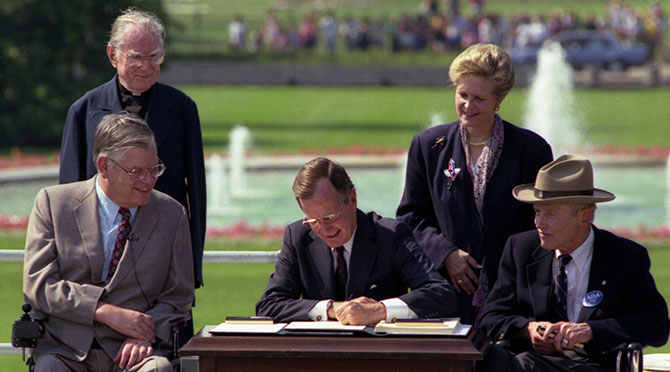I have advocated for the disability community and served as the Special Projects Coordinator at the Bobby Dodd Institute (BDI) for over a decade. Disability Advocacy has become my passion and I truly love the work I get to do. During that time, I’ve had the opportunity to work with hundreds of individuals living with different types of disabilities. Regardless of their condition, I always find a common theme – they all want gainful employment and the opportunity to be productive, independent citizens. I live with a condition called cerebral palsy, so I know this is true. Throughout my career, I have been provided the support I need, but I’ve also been challenged to do more, to achieve more. And I want every person living with a disability to have that same opportunity.
There is top talent in this untapped labor pool, waiting to dedicate their time and skills to the right organization. However, many companies miss out on this opportunity due to a lack of effective disability inclusion practices. By avoiding some common pitfalls, businesses can recruit, hire, and retain individuals with disabilities, ultimately leading to sustainable growth and more opportunities.
Organizations must ensure the entire application process is accessible to all applicants, from job postings and interviews to onboarding procedures. Once employees are hired, companies should train supervisors to understand job accommodations and modifications. Many qualified individuals with disabilities are looking for employment, and companies need to find creative ways to recruit this population.
My previous blog talks about the benefits of hiring people with disabilities. As an employer, you may wonder where to begin. Based on my experiences and my conversations with other individuals living with disabilities, I have found that several universal strategies can help every employer recruit, hire, and support workers with disabilities.
I cover them all in the next several paragraphs.
Build an Inclusive Work Environment
To attract people with disabilities to an organization, companies need to create an inclusive environment for all individuals. When recruiting new employees, actively seek out applicants from the disability community. Try to put applications on job boards targeting job seekers with disabilities. Develop a policy that showcases your organization’s commitment to inclusion in the hiring process. Organizations should take time to review all policies to make sure they are inclusive. These policies include hiring, employee promotion, performance evaluation, and benefits. Celebrate the diverse backgrounds, experiences, and perspectives of all employees. Measure your organization’s inclusive policies through surveys, focus groups, and other ways to collect feedback.
Create Accessible Job Postings
If you are interested in hiring people with disabilities, you must ensure every step of the job application process is accessible, including all job postings and applications. The first step is to provide job postings in multiple formats. Create formats that are compatible with screen readers and other assistive technologies. When writing job posts and advertisements, use clear and concise language that is easy for all applicants to understand, including people with intellectual disabilities. Add promotional messages and welcoming disability-friendly language to posts. Do not use jargon or overly technical words in posts. Job postings should emphasize that your organization is an equal opportunity employer and state that applicants with disabilities should apply. Give contact information to candidates who need accommodations throughout the application or interview process. Design your company’s websites and online applications to be accessible to people with disabilities. These design considerations include keyboard navigation, screen reader compatibility, and adjustable font sizes.
Ensure an Accessible Interview Process
Companies and HR managers must ensure the interview location is accessible to people with disabilities. Consider whether the interview room is wheelchair accessible, providing accessible parking and elevators if needed. If the interview is conducted online, ensure the video conferencing platforms are accessible to screen readers. Inform applicants about the format and expectations of the interview. Give candidates information on how they can request accommodations. Allow applicants to have extra time for interviews. Give them enough time to think about the questions and prepare responses. Also, allow for extra time if applicants are using communication devices. During the interview, speak directly to the job applicant, even if they have an assistant or interpreter with them. Ask questions directly related to the person’s ability to perform job tasks. Only ask questions about a person’s disability if it relates to their ability to perform the job. Be flexible with how the interview is formatted and structure it to fit the applicant’s needs. Interviewers should try to learn about different disabilities and any accommodations that may be needed on the job.
Train Supervisors on Accommodation Practices
To create an inclusive work environment, companies must train their supervisors to work with employees with disabilities and teach them about the accommodation process. Supervisors should familiarize themselves with the different disability laws such as The Americans with Disabilities Act (ADA), the Rehabilitation Act of 1973, the Workforce Innovation and Opportunity Act (WIOA), and other local and state laws. Supervisors need to know the difference between job accommodations and modifications.
According to the ADA, “a job accommodation is any adjustment or modification made to a job or work environment that enables a qualified individual with a disability to perform the essential functions of that job.” Examples of job accommodations are adding a ramp to a building, changing the layout of a workplace, allowing employees to have flexible work schedules, and providing assistive technology equipment to make job tasks more manageable.
The ADA also states, “A job modification refers to changes made to the structure, tasks or requirements of a job to fit better the skills, needs or circumstances of an employee.” Job modifications include co-workers sharing job duties and changing how and when job tasks are performed. For example, a person who has a disability that makes it challenging to write would be allowed to computerize records instead of having to write them manually. Supervisors should know key essential accommodation requirements, including the definition of what a disability is and what a reasonable accommodation is. Ensure that your company has an accommodation policy on how to request them and how to evaluate and grant employee requests. Remind supervisors about the importance of maintaining employee confidentiality and handling sensitive information appropriately. Supervisors should be trained on how to recognize employee’s accommodation requests. Explain the importance of proper documentation in each step of the accommodation process. Give supervisors examples of accommodations such as modified work schedules and assistive technology equipment.
Tips on Accommodating Employees with Disabilities in the Workplace
There are many ways supervisors can best accommodate employees with disabilities. Create a space for open communication among employees where they can express their needs. Be open to offering employees a flexible work schedule or work from home. Ensure that all training and development opportunities are inclusive to all employees. Ensure employees with disabilities have an equal opportunity for job promotions and advancement within the organization. As a supervisor, do not make any assumptions about their capabilities. After adjusting to their jobs, be bold, challenge, and push them to their full potential.
There are many ways that businesses can attract qualified applicants with disabilities to their organizations. Creating an inclusive work environment will help employees feel a sense of belonging within the company. People with disabilities will want to work for an organization when they see the company has hiring policies that are accessible to all employees. Supervisors need to foster the talents of their employees and have a firm understanding of the accommodation process. When an organization actively tries to hire employees with disabilities, the entire company will grow and prosper.

I’m Kylie Moore, from Roswell, Georgia, living with Cerebral Palsy. I’ve dedicated my career to advocating for the disability community, creating self-advocacy programs, and serving on boards. I founded the Ambassador Program at AADD, received the Tom Miller National Advocacy Award in 2020, and now advise Arts InCommunity. When not teaching, I can be found watching the Georgia Bulldogs or my beloved New England Patriots play football or participating in wheelchair sports.




